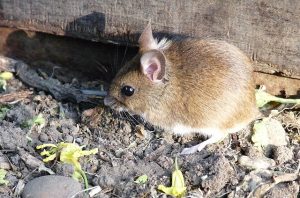This podcast was originally posted in December 2017
Jamie Nack, UW-Extension senior wildlife outreach specialist
Department of Forest and Wildlife Ecology
College of Agricultural and Life Sciences
jlnack@wisc.edu
608-265-8264
Total Time: 3:10
0:19 Why the increase
0:35 Types of pests
0:52 How pests enter
1:40 Keeping pests out
2:57 Lead out
Transcript
Zoey Rugel: Keeping pests out of your home this winter. Today, we’re visiting with Jamie Nack, Extension Senior Wildlife Outreach Specialist, Department of Forest and Wildlife Ecology, University of Wisconsin-Madison/Extension, in the College of Agricultural and Life Sciences, and I’m Zoey Rugel. So, Jamie, why are pests in homes more prevalent this time of year?
Jamie Nack: Well, this time of year with the diminishing daylight and cooler temperatures is when some of the warm-blooded rodents are trying to come into our warm homes for shelter and, in some cases, for food, and they really don’t make very good house guests.
Zoey Rugel: What are the most common types of pests you see entering homes?
Jamie Nack: At this time of the year, small rodents. So, some of the mice, maybe a meadow vole or a short-tailed shrew. Certainly, could have squirrels, whether that be flying squirrels in an attic or tree squirrels. It’s also possible to have a raccoon in the chimney.
Zoey Rugel: How are they usually entering homes?
Jamie Nack: So, and this really is, you know, how you keep them from entering homes, as well then, is, so, they’re entering through, in some cases, really small cracks or crevices, and, so, you’re going to want to go around your home and look at the exterior and see if you have any existing holes and cracks, paying particular attention to the eves and the fascia board and the flashings. Any places you have damp wood that’s rotting is a potential area where insects may inhabit, and insects are a food source for some wildlife and they may be attracted to that area. So, you’re either going to need to use caulk or expandable foam to fill all of these small cracks and crevices or you may have to remove an entire area and reside it or, you know, fix a larger area.
Zoey Rugel: What are the main tips for homeowners to keep pests out?
Jamie Nack: So, the biggest thing is locating those entry points, because you can set as many traps as you want in your home and remove animals and remove animals, but you’re going to continue to have the problem until you’ve dealt with those entry points. Some other places that you want to be checking are the chimney. So, I mentioned raccoons. It’s quite possible to have raccoons denning in your chimney, because of the warmth and the shelter. So, one of the best things you can do there is put a chimney cap on your chimney, and then another thing would be what we call jumping off points. So, looking around the home: where do you branches that extend to your roofline or your gutters? We don’t want squirrels jumping off of existing vegetation or structures to get access. We’re talking about removing vegetation up to eight feet away from the home. One other just general, you know, good recommendation is around the home is to prune your overgrown bushes. If you have a lot of leaves next to the house or you’ve got leaves in your gutters, those are all areas want to kind of clean. The more open you can make that area around your home the less inviting it is for small mammals to be scurrying underneath that vegetation looking for access points. Also, firewood you should really store it outside and away from the home and if you have outdoor trashcans or compost piles, you want to make those unavailable to unwanted guests.
Zoey Rugel: We’ve been visiting today with Jamie Nack, Extension senior wildlife outreach specialist, Department of Forest and Wildlife Ecology, University of Wisconsin-Madison/Extension, in the College of Agricultural and Life Sciences, and I’m Zoey Rugel.



